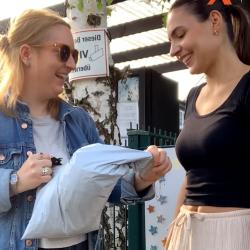Company News • 20.09.2013
New research debunks 'showrooming' myths
Shows brick-and-mortar retailers how to keep smartphone-wielding shoppers spending in-store

With brick–and–mortar–retail stores continuing to struggle with the rise of “showrooming” consumers — those visiting a store to see a product but then purchasing it later online — groundbreaking research from Columbia Business School and global loyalty experts Aimia shows retailers concrete steps they can take to entice consumers armed with mobile devices to make purchases inside their store walls.
The report, Showrooming and the Rise of the Mobile-Assisted Shopper identifies five distinct segments of mobile–assisted shoppers and uncovers clear opportunities for retailers to engage and retain these tech–savvy customers.
“Retailers know that they are operating in a new world, where the shopper in your store with a smartphone has access to every competing outlet and offer,” said David Rogers, a co–author of the study and professor at Columbia Business School. “But retailers are not powerless. To survive, it is critically important that retailers understand the real impact of smartphones on shopper behavior, which will allow them to shape a retail experience that gives mobile consumers a reason to buy in a brick–and–mortar store.”
“Retailers don’t have to resort to automatic price–matching,” states Rick Ferguson, a co–author of the study and the vice president of knowledge development at Aimia. “M–Shoppers show a strong willingness to join loyalty programs in exchange for rewards, and this gives retailers the chance to build long–term relationships with them.”
Key takeaways of the report:
- Showrooming isn’t just for the Millennial Generation: Contrary to popular belief, 74% of M–Shoppers are older than 29 years old.
- Mobile devices can actually improve the chances of an in–store purchase: More than 50% of M–Shoppers are more likely to purchase a product in–store when their mobile device helps them find online reviews, information, or trusted advice.
- Price isn’t always the most important factor: Although “price checking” is the number one action of M–Shoppers, convenience, urgency, and immediacy are the top three reasons why M–Shoppers will buy in–store even if they find the same product cheaper online.
- Loyalty programs are worth more than just their points: 48% of M–Shoppers say that being a member of a store’s loyalty program makes them more likely to purchase products in–store, despite equal or cheaper prices online.
The researchers looked at the attitudes, shopping patterns, and motivations of 3000 leading–edge consumers in the US, UK, and Canada to better understand how mobile devices are impacting their in–store shopping habits; identifying those shoppers most likely to showroom; and outlining actions retailers can take — such as loyalty programs, price matching, free shipping, and mobile payments — to encourage consumers to open their wallets in–store. The results paint a clear picture of today’s mobile assisted shoppers — or M–Shopper — and debunks commonly held assumptions many brick–and–mortar retailers make about retail showroomers.
Luring Back the Five Segments of Mobile–Assisted Shoppers
The research found that there are five distinct types of mobile–assisted shoppers and uncovered clear opportunities for retailers to engage and retain the business of these tech–savvy customers.
- The Exploiters: It would be easy for retailers to write off the Exploiters as a lost cause. But the best opportunity for retailers to win their business may simply be to improve the store’s website. When Exploiters see a product on the shelf and pull out their mobile device, they are nearly as likely to search for it on the store’s own website as on a competitor’s site (69% vs. 77%).
- The Savvys: Although they currently represent only 13% of mobile–assisted shoppers, Savvys are the ripest target for retailers to try out new offers and experiences in the mobile space. They are simultaneously more digitally–savvy, more willing to sign up for loyalty programs, and more likely to be motivated by a range of retailer offers and rewards.
- The Price–Sensitives: Price–Sensitives use their devices in stores periodically, but not as consistently as the other segments. Often, the right in–store experience will be enough to earn the Price–Sensitives’ business. Their mobile devices may be with them, but still remain in their pockets and purses.
- The Traditionalists: These shoppers are committed to purchasing in–store, making them the least threatening segment of mobile–assisted shoppers for retailers. They are open to interacting with retail stores on their mobile devices, whether by website, store app, or even scanning a QR code. But, they are currently using their devices mostly to consult on purchases with friends and family.
- The Experience–Seekers: As the largest of all the segments, Experience–Seekers point to the opportunity for retailers to engage customers on their mobile devices in non–financial ways, with opportunities to comment, provide ratings, etc. And they demonstrate why retailers still need to invest in providing a unique and compelling in-store experience.
“Our findings debunk many of the common assumptions about the threat of showrooming and who is doing it,” said Matthew Quint, a co–author of the study and director of Columbia Business School’s Center on Global Brand Leadership. “Many shoppers with smartphones care about more than just the lowest price on every item. In fact, while roughly 25% of M–Shoppers may require a discount to motivate in–store purchases, a clear majority can be enticed to purchase in–store through information assistance, engagement strategies, and strong loyalty rewards programs.”
Source: Columbia Business School
channels




